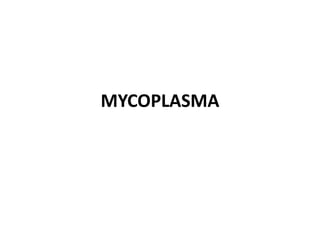
MYCOPLASMA PNEUMONIA INFECTION IN HUMANS
- 1. MYCOPLASMA
- 2. • Mycoplasmas are a group of very small, wall- less organisms, of which Mycoplasma pneumoniae is the major pathogen
- 3. • Mycoplasma (plural mycoplasmas or mycoplas mata) is a genus of bacteria that lack a cell wall around their cell membranes. • This characteristic makes them naturally resistant to antibiotics that target cell wall synthesis (like the beta-lactam antibiotics)
- 4. Important characteristics of mycoplasmal bacteria 1. Cell wall is absent and plasma membrane forms the outer boundary of the cell. 2. Due to the absence of cell wall these organisms can change their shape and are pleomorphic. 3. Lack of nucleus and other membrane-bound organelles. 4. Genetic material is a single DNA. 5. Ribosomes are 70S type.
- 5. Important Properties • Mycoplasmas can be grown in the laboratory on artificial media, but they have complex nutritional requirements, including several lipids. They grow slowly and require at least 1 week to form a visible colony. The colony frequently has a characteristic "fried-egg" shape, with a raised center and a thinner outer edge.
- 7. Genus: Mycoplasma, Ureaplasma Species: M. pneumoniae: Upperrespiratorytract disease, tracheobronchitis,atypical pneumonia M. hominis: Pyelonephritis,pelvicinflammatory disease, postpartumfever M. genitalium: Nongonococclurethritis U. urealyticum: Nongonococclurethritis
- 8. Mycoplasma pneumoniae • M. pneumoniae causes "atypical" pneumonia
- 9. Pathogenesis & Epidemiology • M. pneumoniae, a pathogen only for humans, is transmitted by respiratory droplets. • In the lungs, the organism is rod-shaped, with a tapered tip that contains specific proteins that serve as the point of attachment to the respiratory epithelium.
- 10. • The respiratory mucosa is not invaded, but ciliary motion is inhibited and necrosis of the epithelium occurs. • The mechanism by which M. pneumoniae causes inflammation is uncertain. It does produce hydrogen peroxide, which contributes to the damage to the respiratory tract cells.
- 11. • M. pneumoniae has only one serotype and is antigenically distinct from other species of Mycoplasma. • Immunity is incomplete, and second episodes of disease can occur. • During M. pneumoniae infection, autoantibodies are produced against red cells (cold agglutinins) and brain, lung, and liver cells. These antibodies may be involved in some of the extrapulmonary manifestations of infection.
- 12. • M. pneumoniae infections occur worldwide, with an increased incidence in the winter. This organism is the most frequent cause of pneumonia in young adults and is responsible for outbreaks in groups with close contacts such as families, military personnel, and college students. It is estimated that only 10% of infected individuals actually get pneumonia. Mycoplasma pneumonia accounts for about 5–10% of all community-acquired pneumonia.
- 13. Clinical Findings • Mycoplasma pneumonia is the most common type of atypical pneumonia. • It was formerly called primary atypical pneumonia. (Other atypical pneumonias are legionnaires' disease, Q fever, psittacosis, and viral pneumonias such as influenza. • The term "atypical" means that a causative bacterium cannot be isolated on routine media in the diagnostic laboratory or that the disease does not resemble pneumococcal pneumonia.)
- 14. • The onset of Mycoplasma pneumonia is gradual, usually beginning with a nonproductive cough, sore throat, or earache. • Small amounts of whitish, nonbloody sputum are produced. • Constitutional symptoms of fever, headache, malaise, and myalgias are pronounced. • The paucity of findings on chest examination is in marked contrast to the prominence of the infiltrates seen on the patient's chest x-ray. The disease resolves spontaneously in 10–14 days. In addition to pneumonia, M. pneumoniae also causes bronchitis.
- 15. • The extra-pulmonary manifestations include Stevens-Johnson syndrome, Raynaud's phenomemon, cardiac arrhythmias, arthralgias, and neurologic manifestations such as Guillan-Barre syndrome
- 16. Laboratory Diagnosis • Diagnosis is usually not made by culturing sputum samples; it takes at least 1 week for colonies to appear on special media. Culture on regular media reveals only normal flora.
- 17. • Serologic testing is the mainstay of diagnosis. A cold-agglutinin titer of 1:128 or higher is indicative of recent infection. • Cold agglutinins are IgM autoantibodies against type O red blood cells that agglutinate these cells at 4°C but not at 37°C. • However, only half of patients with Mycoplasma pneumonia will be positive for cold agglutinins. The test is nonspecific; false-positive results occur in influenza virus and adenovirus infections.
- 18. • The diagnosis of M. pneumoniae infection can be confirmed by a fourfold or greater rise in specific antibody titer in the complement fixation test
- 19. Treatment • The treatment of choice is either a macrolide, such as erythromycin or azithromycin, or a tetracycline, such as doxycycline. • These drugs can shorten the duration of symptoms, although, as mentioned above, the disease resolves spontaneously. • Penicillins and cephalosporins are inactive because the organism has no cell wall
- 20. Prevention • There is no vaccine or other specific preventive measure.
Editor's Notes
- Mycoplasma pneumoniae is a very small bacterium in the class Mollicutes
- In 1898, Nocard and Roux were the first to isolate an agent assumed to be the cause of cattle pneumonia
- Mycoplasma species have been isolated from women with bacterial vaginosis.[3] M. genitalium is found in women with pelvic inflammatory disease.[9] In addition, infection is associated with increased risk of cervicitis, infertility, preterm birth and spontaneous abortion.[10] Mycoplasma genitalium has developed resistance to some antibiotics.[11] Mycoplasmas are associated with infant respiratory distress syndrome, bronchopulmonary dysplasia, and intraventricular hemorrhage in preterm infants.[